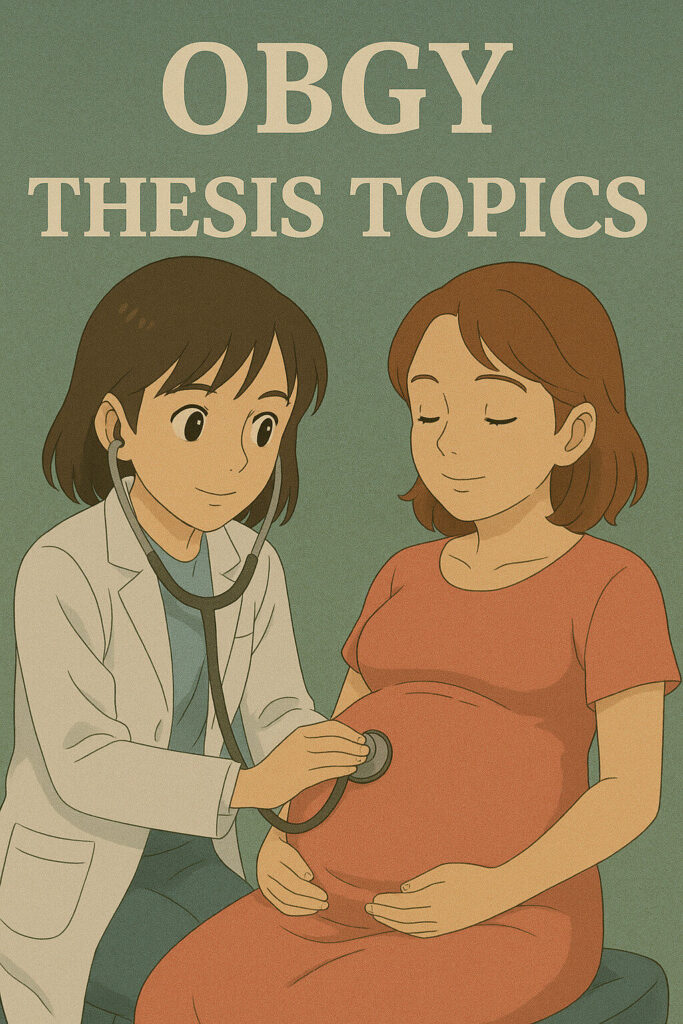OBSTETRICS AND GYNECOLOGY THESIS TOPICS

OBGY THESIS TOPICS
Selecting the right OBGY thesis topics is a foundational step in addressing critical issues in women’s health and reproductive medicine. Relevant OBGY thesis topics span areas such as maternal-fetal medicine, infertility, gynecological oncology, urogynecology, reproductive endocrinology, contraception, and high-risk pregnancies. A carefully chosen OBGY thesis topic ensures that the research is aligned with both clinical needs and scientific advancements.
A well-structured thesis on impactful OBGY thesis topics can be refined for publication in reputed medical journals, which is a key requirement for faculty promotions and appointments in medical colleges. Focusing on progressive OBGY thesis topics enables medical professionals to contribute to policy development, patient safety, and clinical excellence in obstetrics and gynecology, ultimately improving outcomes for women worldwide.
1. Maternal–Fetal Medicine & High-Risk Pregnancy
A prospective cohort study of first-trimester serum PAPP-A and PlGF levels for prediction of preeclampsia in high-risk women
A randomized controlled trial of low-dose aspirin versus placebo in prevention of preeclampsia among women with chronic hypertension
A cross-sectional analysis of uterine artery Doppler indices and fetal growth restriction outcomes in the third trimester
A retrospective cohort evaluation of maternal and neonatal outcomes in type 1 versus type 2 diabetic pregnancies
An in vitro dual-perfusion placental model assessing transplacental transfer of novel antiretroviral agents
A case-control study of amniotic fluid cytokine profiles in spontaneous preterm labor versus term controls
A methodological validation of noninvasive fetal electrocardiography for early detection of fetal distress during labor
A systematic review and meta-analysis of vitamin D supplementation effects on gestational diabetes mellitus incidence
An in silico predictive model combining clinical and ultrasound parameters to forecast preterm birth risk
A narrative review of emerging biomarkers and therapeutics in antiphospholipid syndrome management during pregnancy
2. Intrapartum Management & Labor Interventions
A randomized controlled trial comparing continuous cardiotocography versus intermittent auscultation for detection of fetal distress in low-risk labor
A prospective observational study of partograph adherence and its association with labor outcomes in district hospitals
A case-control study of epidural analgesia versus parenteral opioids on maternal fever and neonatal sepsis markers
A retrospective cohort analysis of active third-stage management (oxytocin versus misoprostol) and postpartum hemorrhage rates
An in vitro assessment of anti-inflammatory cytokines in amniotic fluid during induced versus spontaneous labor
A methodological validation of wireless fetal ECG ST segment analysis for hypoxia detection during labor
A cross-sectional survey comparing maternal satisfaction and pain scores with nitrous oxide inhalation versus combined spinal–epidural analgesia
A systematic review and meta-analysis of delayed versus early umbilical cord clamping on neonatal hematologic outcomes
An in silico modeling study of oxytocin dosing algorithms based on uterine contraction patterns
A narrative review of simulation-based training for management of obstetric emergencies during labor
3. Postpartum Complications & Care
A cross-sectional evaluation of postpartum depression prevalence using the Edinburgh Postnatal Depression Scale in urban slum populations
A randomized controlled trial of midwife-led home visits versus routine care on breastfeeding success and maternal well-being at 6 weeks postpartum
A retrospective cohort study of postpartum hemorrhage management (balloon tamponade versus surgical intervention) and maternal morbidity
A prospective observational study of pelvic floor muscle strength recovery after vaginal delivery using perineometry
A case-control analysis of subinvolution of the uterus and serum fibrinogen levels in women with prolonged lochia
A methodological validation of point-of-care hemoglobin measurement devices for detection of postpartum anemia
An in vitro analysis of breast milk cytokine profiles in mothers with mastitis versus healthy controls
A systematic review and meta-analysis of iron supplementation strategies for postpartum anemia treatment
An in silico predictive model of lactation duration based on maternal and neonatal clinical variables
A narrative review of telehealth interventions for postpartum mental health and lactation support
4. Reproductive Endocrinology & Infertility
A prospective cohort study of anti-Müllerian hormone levels and ovarian reserve decline in chemotherapy-exposed breast cancer survivors
A randomized controlled trial of letrozole versus clomiphene citrate for ovulation induction in polycystic ovary syndrome: ovulation and pregnancy rates
A cross-sectional investigation of kisspeptin serum levels in hypothalamic amenorrhea versus eumenorrheic controls
A retrospective cohort analysis of IVF outcomes and serum progesterone on the day of hCG trigger
An in vitro granulosa cell culture study evaluating resveratrol effects on steroidogenesis and oxidative stress markers
A case-control genetic association study of FSH receptor polymorphisms in poor versus normal responders in ART cycles
A methodological validation of endometrial receptivity array versus ultrasound assessment for embryo transfer timing
A systematic review and meta-analysis of acupuncture as adjunct therapy in improving IVF success rates
An in silico network pharmacology study of herbal compounds modulating endometrial receptivity in recurrent implantation failure
A narrative review of advances in oocyte and embryo cryopreservation techniques: vitrification versus slow-freezing
5. Contraception & Family Planning
A cross-sectional survey of contraceptive knowledge, attitudes, and uptake among postpartum women in rural health centers
A randomized open-label trial comparing etonogestrel implant versus levonorgestrel IUD: continuation rates and side-effect profiles
A retrospective cohort study of method-switch patterns and discontinuation reasons among combined oral contraceptive users
A case-control evaluation of progestin-only pill adherence and lactation outcomes in breastfeeding mothers
An in vitro endometrial explant assay assessing ulipristal acetate effects on endometrial histology
A methodological validation of home pregnancy tests versus clinic-based β-hCG assays for early detection of contraceptive failure
A systematic review and meta-analysis of efficacy and safety of male hormonal contraception methods
An in silico modeling study of population-level impact of contraceptive method mix on unintended pregnancy rates
A prospective observational study of postpartum IUD insertion timing (immediate versus delayed) on expulsion rates
A narrative review of emerging non-hormonal contraceptive technologies: RISUG and immunocontraception
6. Gynecologic Oncology
A prospective cohort study of HPV genotype distribution and cervical lesion progression in immunocompromised versus immunocompetent women
A randomized controlled trial of carboplatin–paclitaxel versus cisplatin–capecitabine as adjuvant therapy in early-stage epithelial ovarian cancer
A cross-sectional evaluation of serum HE4 and CA-125 for early detection of ovarian malignancy in high-risk populations
A retrospective cohort analysis of sentinel lymph node mapping versus full lymphadenectomy in endometrial cancer staging: morbidity and detection rates
An in vitro cytotoxicity assay of novel PARP inhibitors on BRCA-mutated versus wild-type ovarian cancer cell lines
A case-control study of circulating microRNA signatures in vulvar squamous cell carcinoma patients versus controls
A methodological validation of narrow-band imaging endoscopy for margin delineation in premalignant cervical lesions
A systematic review and meta-analysis of bevacizumab addition to chemotherapy in recurrent cervical cancer: response and survival
An in silico docking study of targeted small molecules against p53–MDM2 interaction in endometrial carcinoma
A narrative review of immunotherapy (checkpoint inhibitors, adoptive T-cell therapy) in gynecologic malignancies
7. Urogynecology & Pelvic Floor Disorders
A prospective cohort study of pelvic organ prolapse quantification (POP-Q) progression and risk factors in multiparous women
A randomized double-blind trial of vaginal estrogen cream versus placebo for genitourinary syndrome of menopause: symptom relief and urodynamic changes
A cross-sectional urodynamic study of detrusor overactivity in diabetic versus non-diabetic women with urinary incontinence
A retrospective cohort evaluation of transobturator versus retropubic sling procedures for stress urinary incontinence: 5-year outcomes
An in vitro collagen crosslinking assay of pelvic floor connective tissue from women with versus without prolapse
A case-control study of pelvic floor muscle strength using perineometry in women with mixed urinary incontinence versus controls
A methodological validation of dynamic pelvic MRI versus ultrasound for pelvic floor dysfunction diagnosis
A systematic review and meta-analysis of sacral neuromodulation versus botulinum toxin injections in refractory overactive bladder
An in silico biomechanical modeling of pelvic support structures under Valsalva maneuver to predict prolapse risk
A narrative review of regenerative medicine approaches for pelvic floor reconstruction
8. Minimally Invasive & Robotic Gynecologic Surgery
A prospective randomized trial of robotic-assisted versus conventional laparoscopic hysterectomy: perioperative outcomes and cost-effectiveness
A cross-sectional evaluation of surgeon ergonomics and musculoskeletal stress in single-port versus multi-port laparoscopy
A retrospective cohort study of in-bag versus open morcellation techniques and risk of tissue dissemination in fibroid removal
An in vitro assessment of thermal spread and vessel sealing efficacy of advanced bipolar versus ultrasonic devices in gynecologic surgery
A case-control analysis of postoperative adhesion formation rates with and without antiadhesion barrier use in endometriosis surgery
A methodological validation of 3D-printed pelvic models for preoperative planning in complex endometriosis cases
A systematic review and meta-analysis of laparoscopic versus open myomectomy: fertility and symptom outcomes
An in silico simulation of uterine suturing techniques and their impact on uterine wall integrity postpartum
A pilot clinical study of augmented reality navigation systems in laparoscopic gynecologic oncology procedures
A narrative review of natural orifice transluminal endoscopic surgery (NOTES) applications in gynecology
9. Adolescent, Menopause & Reproductive Immunology
A cross-sectional study of menstrual irregularities and quality-of-life scores in adolescent girls with polycystic ovary syndrome versus controls
A prospective cohort analysis of hormone replacement therapy regimens on cardiovascular risk markers in early versus late postmenopausal women
A retrospective cohort evaluation of bone density and turnover markers in premature ovarian insufficiency patients
An in vitro co-culture assay of endometrial epithelial and immune cells from women with recurrent pregnancy loss: cytokine interaction profiling
A case-control study of cervical immune cell populations and microbiome composition in adolescents post-HPV vaccination versus unvaccinated
A methodological validation of transvaginal ultrasound antral follicle count reliability in adolescents versus adult women
A systematic review of nonhormonal treatments for vasomotor symptoms in menopausal women: efficacy and safety
An in silico network analysis of immune checkpoint gene expression in endometriosis lesions
A pilot observational study of vaginal microbiome transplantation for refractory bacterial vaginosis in postmenopausal women
A narrative review of regenerative therapies (stem cells, platelet-rich plasma) in Asherman’s syndrome
10. Recent Advances in Obstetrics & Gynecology
A scoping review of artificial intelligence–driven ultrasound image analysis for automated anomaly detection in fetal scans
A prospective pilot study of telehealth-guided remote fetal heart rate monitoring using wearable devices in low-resource settings
A methodological assessment of organ-on-a-chip placental models for drug transport and toxicity screening
An in vitro validation of exosome-based biomarkers from maternal plasma for early detection of preeclampsia
An in silico multi-omics integration of endometrial receptivity gene and protein data for personalized embryo transfer timing
A systematic review and meta-analysis of CRISPR-Cas9–based gene-editing applications in congenital uterine anomaly models
A narrative review of 3D bioprinted cervical tissue for cervical insufficiency treatment: preclinical and early clinical data
A pilot trial of photobiomodulation therapy for accelerating postpartum perineal wound healing
A retrospective data-mining analysis of electronic health record big data to predict cesarean delivery indications and outcomes
A narrative review of microbiome-modulating therapeutics for bacterial vaginosis and reproductive health



